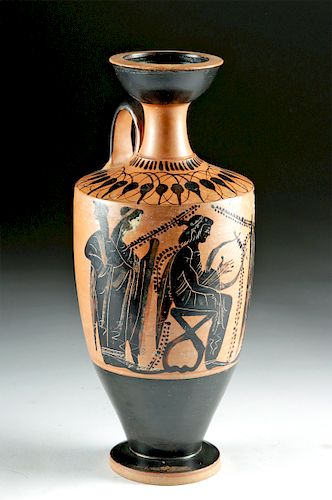Attic Black-Figure Lekythos - Class of Athens 581 w/ TL
Lot 31
About Seller
Artemis Gallery
686 S Taylor Ave, Ste 106
Louisville, CO 80027
United States
Selling antiquities, ancient and ethnographic art online since 1993, Artemis Gallery specializes in Classical Antiquities (Egyptian, Greek, Roman, Near Eastern), Asian, Pre-Columbian, African / Tribal / Oceanographic art. Our extensive inventory includes pottery, stone, metal, wood, glass and textil...Read more
Estimate:
$12,500 - $16,000
Absentee vs Live bid
Two ways to bid:
- Leave a max absentee bid and the platform will bid on your behalf up to your maximum bid during the live auction.
- Bid live during the auction and your bids will be submitted real-time to the auctioneer.
Bid Increments
| Price | Bid Increment |
|---|---|
| $0 | $25 |
| $300 | $50 |
| $1,000 | $100 |
| $2,000 | $250 |
| $5,000 | $500 |
| $10,000 | $1,000 |
| $20,000 | $2,500 |
| $50,000 | $5,000 |
| $100,000 | $10,000 |
| $200,000 | $20,000 |
About Auction
By Artemis Gallery
Feb 21, 2019
Set Reminder
2019-02-21 10:00:00
2019-02-21 10:00:00
America/New_York
Bidsquare
Bidsquare : Exceptional Antiquities, Asian, Ethnographic
https://www.bidsquare.com/auctions/artemis-gallery/exceptional-antiquities-asian-ethnographic-3858
An important one-day auction featuring museum-worthy examples of Egyptian, Greek, Roman, Etruscan, Near Eastern, Far East / Asian, Pre-Columbian, African / Tribal, Oceanic, Native American, Spanish Colonial, Russian, Fossils, Ancient Jewelry, Fine Art, so much more! Artemis Gallery info@artemisgallery.com
An important one-day auction featuring museum-worthy examples of Egyptian, Greek, Roman, Etruscan, Near Eastern, Far East / Asian, Pre-Columbian, African / Tribal, Oceanic, Native American, Spanish Colonial, Russian, Fossils, Ancient Jewelry, Fine Art, so much more! Artemis Gallery info@artemisgallery.com
- Lot Description
Ancient Greece, Athens, attributed to Class of Athens 581, ca. early 5th century BCE. A beautiful black-figure cylindrical lekythos, the central register featuring a seated Apollo playing a lyre and flanked by four draped Muses or goddesses. Elegant grapevine tendrils grace the spaces between the figures. Complimenting this iconographic program is a lovely frieze of lotus buds adorning the vessel's shoulder, and lustrous black glaze envelops the lower section of the body to the upper surface of the foot as well as the spout and single, gently arching strap handle. Note the artist's attention to details - many incised marks to delineate drapery folds, facila features, and the strings of the lyre. Furthermore, added/fugitive paint in white and yellow hues adorns the attendants' faces and garments. Size: 4.5" in diameter x 10.75" H (11.4 cm x 27.3 cm)
According to John Boardman, "A large group of the early fifth century, the Class of Athens 581, stands on its own, and centres on the work of the Marathon Painter who supplied many of the lekythoi deposited in the tumulus raised over those who fell in the battle of 490." (J. Boardman, "Athenian Black Figure Vases", p. 148)
Athens excelled in ceramics from the first half of the sixth century BCE, and its creations outnumbered those of all other artistic centers in the ancient world. Greek pottery became synonymous with Attic ware, the pottery created in the region around Athens, as it was regarded as the most beautiful and the most 'modern', and thus, the most widely exported. Artists used the black-figure vase painting technique, applying figural and ornamental motifs with a slip that turned black during the firing process; however the background remained the inherent color of the clay. As we see in this example, vase painters articulated individual forms by incising the slip. Sometimes additional white and yellow slip details were added, as we see in this example. The form of representation was still somewhat Archaic, with heads and bodies shown in strict profile; however, this example begins to demonstrate an interest in three-dimensional modelling of the figures and conveying movement and the illusion of depth.
Lekythoi were used for storing oil used for a wide variety of purposes in the Classical World. While larger examples were usually designated for keeping olive oil, smaller more delicate examples were reserved for the bath to store precious unguents of sweet and floral aromas.
This piece has been tested using thermoluminescence (TL) analysis and has been found to be ancient and of the period stated. A full report will accompany purchase.
Provenance: private East Coast, USA collection
All items legal to buy/sell under U.S. Statute covering cultural patrimony Code 2600, CHAPTER 14, and are guaranteed to be as described or your money back.
A Certificate of Authenticity will accompany all winning bids.
We ship worldwide and handle all shipping in-house for your convenience.
#141445Small chip to rim. Back side of vessel repaired from multiple pieces, but very well done. TL hole to underside of base. Expected surface wear commensurate with age, but imagery is quite vivid and some fugitive white/yellow pigments remain.Condition
- Shipping Info
-
All shipping is handled in-house for your convenience. Your invoice from Artemis Gallery will include shipping calculation instructions. If in doubt, please inquire BEFORE bidding for estimated shipping costs for individual items.
-
- Buyer's Premium



 EUR
EUR CAD
CAD AUD
AUD GBP
GBP MXN
MXN HKD
HKD CNY
CNY MYR
MYR SEK
SEK SGD
SGD CHF
CHF THB
THB
















